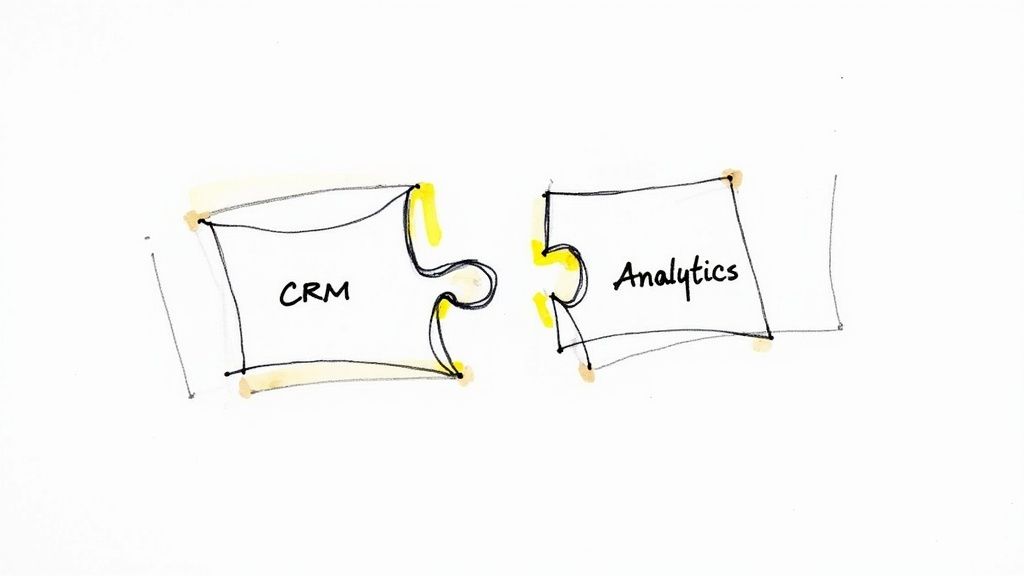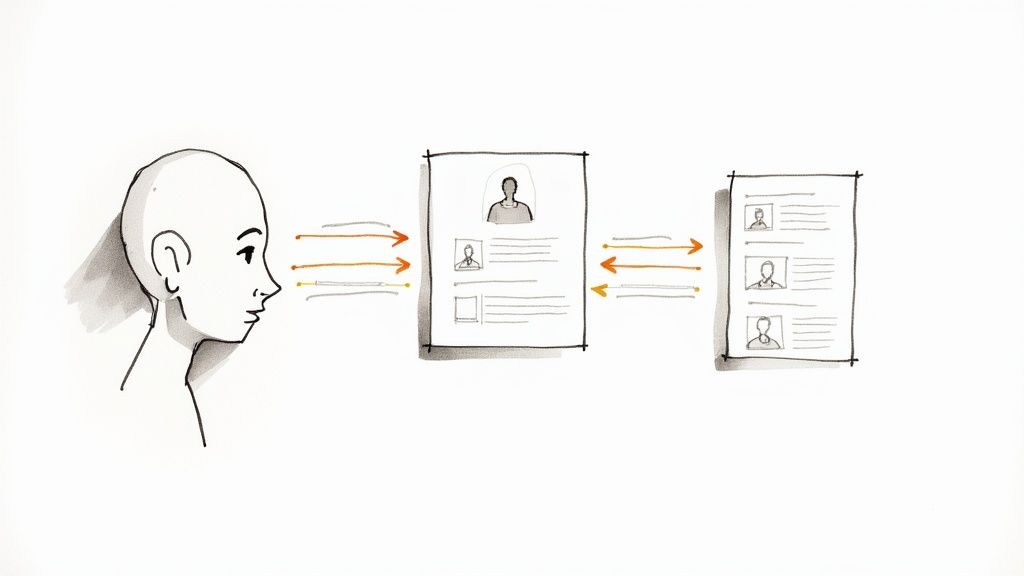
Mastering Lead Generation for Healthcare: Proven Strategies for 2025
Master lead generation for healthcare with proven strategies for 2025. Learn to attract, nurture, and convert quality leads in the complex healthcare market.

To get started with AI in marketing, it’s best to think in three simple stages: lay out your strategy by defining what you want to achieve, move to implementation by picking the right tools for things like personalization or content creation, and finally, focus on optimization by measuring your results to see what’s working. This simple path helps you get past the hype and drive real growth.
Artificial intelligence isn't some far-off concept anymore; it's a practical tool that businesses of every size are putting to work. You don't need a massive budget to get started. The trick is to understand its two main jobs in the marketing world.
First, there's predictive analytics. This is where AI sifts through your data to make educated guesses about what customers will do next. Think of it like a smart assistant that looks at past purchases and browsing habits to suggest the perfect product, fueling hyper-personalized recommendations and sharper ad campaigns.
The other side of the coin is generative AI, which, as the name suggests, creates brand-new content. This is the tech that can whip up social media updates, brainstorm blog ideas, or write five different versions of ad copy in the time it takes to grab a coffee. It’s a massive time-saver and a huge creative boost.
I find it helpful to think about the primary ways AI is being applied to solve common marketing challenges. This table breaks it down nicely.
Ultimately, whether you're personalizing customer journeys, creating content at scale, or digging into analytics, AI offers a powerful set of tools to get the job done more effectively.
The goals you set for your marketing will point you toward the right kind of AI. Are you trying to understand your audience better, or do you need to create more content, faster? This decision tree can help you map your objective to the right AI approach.

As you can see, knowing whether you need to predict behavior or generate content is the critical first step. Getting this right from the start saves a lot of headaches down the road.
The move to AI isn't just a trend; it's a fundamental shift. A recent Nielsen report predicts that by 2025, a staggering 80% of companies worldwide will be using AI for marketing measurement and personalization. You can learn more about these global marketing insights from Nielsen.
This highlights a massive pivot toward data-informed strategies. In fact, adoption is even higher in North and Latin America, hitting 85%. For many, working with a skilled data-driven marketing agency can be the key to navigating this transition and staying competitive.

Jumping into AI marketing can feel like walking into a massive, noisy warehouse of shiny new gadgets. With so many options, it’s easy to get overwhelmed and just pick the one with the flashiest website. The secret isn't to find the "best" tool, but the right tool for your specific problem.
Start by pinpointing your biggest marketing headache. What's keeping you up at night?
Each of these challenges points to a different category of AI software. For example, a small e-commerce brand might get the biggest win from an AI personalization engine that suggests products based on browsing history. A B2B company, on the other hand, would likely get more value from an AI-powered content optimizer to climb search rankings and pull in more organic traffic.
Once you’ve identified your core challenge, you can start evaluating potential solutions. It's not just about features; it’s about fit. How well will a new tool integrate with the systems you already use every day, like your CRM or email platform? A powerful tool that doesn’t communicate with your other software will just create more work and another data silo.
Don't chase the latest trend. The most effective AI strategy involves selecting tools that solve a real, measurable problem within your current marketing workflow. This ensures a clear path to actually seeing a return on your investment.
When you're evaluating different AI solutions for your content needs, it's helpful to see how they stack up. A good comparison of AI writing tools can save you hours of research by laying out the pros and cons of different platforms.
The market for these solutions is exploding. The global AI market is valued at around $279.22 billion in 2024 and is expected to hit $1.81 trillion by 2030. That's not just a big number; it shows how quickly businesses are putting this tech to work. This growth means more options for us, making a clear and focused selection process more important than ever.
To help you get started, here's a quick comparison of tool types based on common marketing goals.
Ultimately, the goal is to find a tool that doesn't just add another subscription to your budget but actively solves a problem and makes your team more effective.

The days of blasting the same marketing message to everyone are long gone. Customers now expect you to understand their specific needs and interests. This is where AI stops being a buzzword and starts being your most valuable player. AI digs through data you have—website clicks, purchase history, email opens—and pieces together incredibly detailed profiles of your customers.
This means you can move past clumsy, broad audience segments and start creating experiences that feel like they were made for one person. Think about an e-commerce site that uses AI to dynamically change its homepage. It could showcase new hiking boots to a known outdoor lover while highlighting the latest fashion trends for another shopper. That's the kind of personal touch that makes customers feel seen.
This isn't just a trend; it's rapidly becoming the standard. A 2025 survey found that 88% of marketers use AI tools every single day. On top of that, 51% are already using AI specifically for content optimization—tweaking messages for different people. You can see more stats on AI's role in personalization here.
The magic of AI in marketing is its ability to build one-to-one connections that turn a casual buyer into a loyal fan. It’s about shifting from static segments to fluid, individual journeys.
AI doesn’t just guess what your customers might want. It actively predicts their next move based on their real-time behavior, letting you deliver the perfect message at the perfect time.
For example: someone leaves items in their shopping cart. Instead of a boring "Did you forget something?" email, an AI-powered system can do something smarter. It might send a personalized message with a small discount on those exact items or suggest similar products that just came back in stock.
These hyper-relevant moments are exactly what you need when you're figuring out how to increase website conversions and build relationships that last.

The constant pressure to produce fresh, high-quality content is a major headache for most marketing teams. It’s a relentless cycle that can burn out even the most creative minds. This is where AI really shines—not as a replacement for your team, but as a powerful creative partner.
Instead of wrestling with a blank screen, you can have AI brainstorm blog post ideas or map out an entire content pillar in minutes. It's fantastic for churning out first drafts of social media updates, email newsletters, or ten different ad copy variations for A/B testing.
This frees up your team to do what they do best: think strategically. For instance, using an AI video script generator can handle the heavy lifting of drafting compelling narratives, letting your team focus on the final polish and production.
Here’s the thing, though: raw AI output is almost always generic. It lacks the personality, stories, and unique perspective that make your brand stand out.
That’s why you should treat AI-generated text as a starting point, not the final product. This is where your team's expertise becomes absolutely essential.
The real skill in using AI for content isn't just about writing the perfect prompt. It’s about taking what the AI gives you and editing it until it sounds authentic, accurate, and perfectly in sync with your brand’s voice.
Always double-check any data or claims the AI spits out. More importantly, get in there and rewrite sections to inject your brand's unique tone, add real-world anecdotes, and make sure the content actually resonates with your audience.
Here’s a simple checklist for refining AI-generated drafts:
Let's be honest—getting new AI tools is the fun part. But the real victory comes when you can prove they're actually making you money. If you can't connect your AI marketing efforts to real results, you're just guessing.
The key is to look past the "feel-good" numbers and zero in on the metrics that matter to your business. Are those AI-crafted emails actually boosting your conversion rate? Is that new personalization tool increasing your average customer lifetime value (CLV)?
One of the biggest indicators you're on the right track is a drop in your cost per acquisition (CPA). A well-tuned AI strategy should make acquiring new customers cheaper and more efficient.
Here's the cool part: the same AI that runs your campaigns can also be your best analyst. It can spot trends and patterns in your data that a human eye would easily miss, telling you exactly which moves are paying off.
This creates a powerful cycle of improvement. Think of it like this:
You're not just running campaigns; you're creating a learning machine. Every single action provides data that sharpens your strategy for the next time, turning your initial investment into sustained growth.
When you can clearly show how your AI tools are impacting the bottom line, getting more budget and expanding your efforts becomes a much easier conversation.
For a complete breakdown of the formulas and frameworks, check out our guide on how to measure marketing ROI.
As you start digging into how AI can fit into your marketing, a few questions are bound to pop up. Let's tackle some of the most common ones I hear from other marketers so you can move forward with a clear head.
Let's clear this up right away: No, AI isn't here to replace marketers. It's here to make us better at our jobs. AI is fantastic at handling the tedious, data-heavy tasks that eat up our time. This frees us up to focus on what really moves the needle—strategy, creative thinking, and connecting with customers on a human level.
The marketers who thrive won't be replaced by AI; they'll be the ones who learn how to work with AI. Think of it as the ultimate assistant. It does the grunt work, you provide the big-picture thinking and strategic direction.
You absolutely don't need a massive budget to get started. The trick is to start small, prove the concept, and then build from there.
This is a big one, and it mostly comes down to data privacy and being transparent. You have to be crystal clear with your customers about how you're using their data for things like personalization. And, of course, you need to follow data protection laws like GDPR to the letter.
The other major concern is algorithmic bias. It's a real risk. An AI model can inadvertently learn biases from the data it's trained on, leading to marketing that feels unfair or exclusionary. The only way to counter this is to constantly check your AI systems for bias. The end goal is always to create campaigns that are respectful and genuinely helpful, never manipulative or creepy.
Ready to see what a results-focused, AI-driven strategy can do for your business? BrandBooster.ai combines expert marketing knowledge with powerful technology to deliver real returns. We guarantee results in 60 days, or you don't pay. Start growing your brand today.